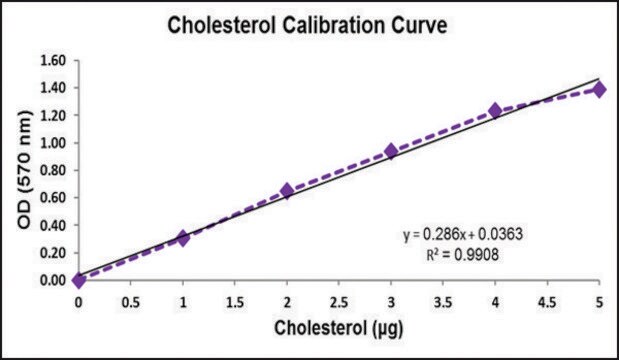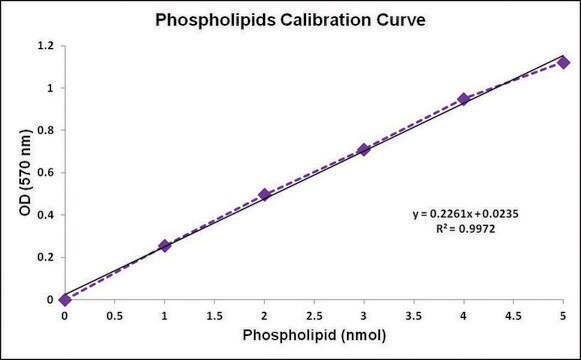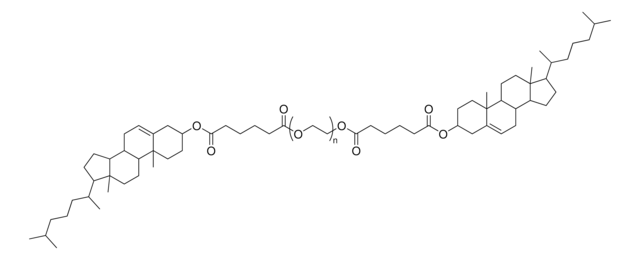428901
Cholesterol/Cholesteryl Ester Quantitation Kit
About This Item
Recommended Products
usage
sufficient for 100 tests
Quality Level
packaging
pkg of 1 96-well plate(s)
manufacturer/tradename
Calbiochem®
storage condition
OK to freeze
protect from light
assay range
standard curve range: 0.2-10 μg/well
input
sample type serum
sample type cells
sample type tissue(s)
shipped in
wet ice
storage temp.
−20°C
General description
Components
Warning
Preparation Note
2. Cell Lysates and Tissue Extracts: Homogenize 1 x 106 cells or 10 mg tissue in 200 µl Chloroform:Isopropanol:NP-40 (7:11:0.1) in a microhomogenizer. Centrifuge for 5-10 min at 14,000 rpm in a microcentrifuge. Avoiding the whitish solid protein layer, collect the organic phase (lower phase) and transfer it to a clean tube; air-dry at 50°C, and vacuum-dry for 30 min to remove residual chloroform. Dissolve the dried lipids in 200 µl Cholesterol Reaction Buffer by vortexing extensively for 5 min. Use 1-50 µl extracted sample per assay. The extraction procedure can be scaled up if larger amounts of sample are desired. Use 1-50 µl of extracted sample per assay. Then adjust the volume to 50 µl/well with Cholesterol Assay Buffer. For unkown samples, we suggest testing differant amounts of sample to ensure that the readings are within the linear portion of the standard curve.
• Cholesterol Probe: Ready to use as supplied. Warm to room temperature to thaw the DMSO solution before use. Aliquot and freeze at -20°C; protect from light. Cholesterol Probe is stable for up to 2 months at -20°C.
• Cholesterol Esterase: Dissolve the Cholesterol Esterase in 220 l Cholesterol Reaction Buffer prior to use. Aliquot and freeze at -20°C. Reconstituted Cholesterol Esterase is stable for up to 2 months at -20°C.
• Enzyme Mix: Dissolve the Enzyme Mix in 220 l Cholesterol Reaction Buffer prior to use. Aliquot and freeze at -20°C. Reconstituted Enzyme Mix is stable for up to 2 months at -20°C.
• Standard Curve, Colorimetric Detection: Dilute the Cholesterol Standard to a concentration of 0.5 g/l by adding 20 l Cholesterol Standard to 180 l Cholesterol Reaction Buffer; mix well. Add the indicated volumes of diluted Cholesterol Standard and Cholesterol Reaction Buffer (see table below) to individual designated standard wells.
<div class="Bio_doc_image"><p class="title">Table 1: Sample Dilutions
</div>
• Standard Curve, Fluorometric Detection: Dilute the Cholesterol Standard to 50 ng/l by adding 10 l Cholesterol Standard to 990 l Cholesterol Reaction Buffer; mix well. Add the indicated volumes of diluted Cholesterol Standard and Cholesterol Reaction Buffer (see table below) to individual designated standard wells.
<div class="Bio_doc_image">Table 2: Sample Dilutions
</div>
Note: For the standard curve (colorimetric and fluorescent detection), cholesterol esterase MUST be added to the reaction mix for detecting either total cholesterol or free cholesterol.
• Reaction Mix: Prepare the following Reaction Mix; prepare only enough reaction mix for the number of assays to be performed. The total volume of reaction mix in each well is 50 l.
44 l Cholesterol Reaction Buffer
2 l Cholesterol Probe
2 l Enzyme Mix
2 l Cholesterol Esterase*
*Note: Cholesterol Esterase hydrolyzes cholesteryl ester into cholesterol. If you want to detect cholesterol only, omit the Cholesterol Esterase. With the addition of Cholesterol Esterase, the assay detects both cholesterol and cholesteryl esters. If you want to detect cholesteryl esters only, subtract the value of cholesterol from the total value of both cholesterol and cholesteryl esters.
Legal Information
Signal Word
Danger
Hazard Statements
Precautionary Statements
Hazard Classifications
Resp. Sens. 1 - Skin Sens. 1
Storage Class Code
10 - Combustible liquids
Regulatory Listings
Regulatory Listings are mainly provided for chemical products. Only limited information can be provided here for non-chemical products. No entry means none of the components are listed. It is the user’s obligation to ensure the safe and legal use of the product.
JAN Code
428901-1KIT:
428901-PKIT:
Certificates of Analysis (COA)
Search for Certificates of Analysis (COA) by entering the products Lot/Batch Number. Lot and Batch Numbers can be found on a product’s label following the words ‘Lot’ or ‘Batch’.
Already Own This Product?
Find documentation for the products that you have recently purchased in the Document Library.
Customers Also Viewed
Our team of scientists has experience in all areas of research including Life Science, Material Science, Chemical Synthesis, Chromatography, Analytical and many others.
Contact Technical Service









